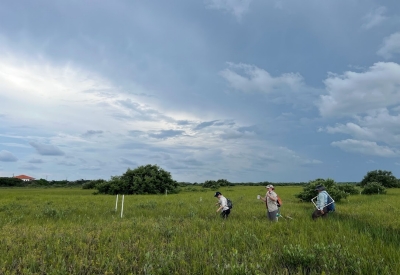Villanova Biology Professors Receive $1 Million National Science Foundation Grant for Wetlands Research

VILLANOVA, Pa.—Villanova University’s Samantha Chapman, PhD, and Adam Langley, PhD, professors in the Department of Biology and two of the founding faculty of the Center of Biodiversity and Ecosystem Stewardship in the College of Liberal Arts and Sciences, are principal investigators on a $1 million grant from the National Science Foundation (NSF) to support their project, “The Interplay of Nitrogen Loading and Ecosystem Sustainability in Threatened Wetlands.”
“Drs. Chapman and Langley’s research is critical to our understanding of climate change, and this grant is a testament to the value of their work to the scientific community and the public, says Adele Lindenmeyr, PhD, William and Julia Moulden Dean. “We are also grateful for the opportunities this NSF grant allows for our students, as Drs. Chapman and Langley will be able to involve more undergraduate and graduate researchers in their important work.”
Nitrogen pollution from fertilizer, septic tanks, and cities often courses over wetlands, which help extract this pollutant from surrounding waters. A healthy wetland can remove large amounts of nitrogen from the environment, but some evidence suggests too much nitrogen can overwhelm a wetland and cause it to collapse.
The grant will fund experiments in marshes and mangrove swamps around St. Augustine, Florida. Florida produces high levels of nutrient pollution, resulting in fish and manatee die-offs, among many other negative effects. The project aims to learn more about the effect nutrient pollution has on coastal wetlands and how ecosystems can help remove nutrients.
“This research has very tangible and pressing implications for the ecosystems that protect our coastline and the people that rely on them,” Langley said. “We are posing challenging questions that we hope can be answered with experimentation in complex and dynamic ecosystems. Without substantial support from agencies like NSF, we couldn’t establish experiments on this scale in these harsh environments and run them for long enough to see the results unfold.”
The grant also secures funding for two Villanova graduate students and several undergraduate students to assist in conducting the research. Villanova will collaborate with the University of Central Florida and The Guana Tolomato Matanzas National Estuarine Research Reserve.
About Villanova University’s College of Liberal Arts and Sciences: Since its founding in 1842, Villanova’s College of Liberal Arts and Sciences has cultivated knowledge, understanding and intellectual courage for a purposeful life in a challenging and changing world. With more than 40 majors across the humanities, social sciences and natural sciences, it is the oldest and largest of Villanova’s colleges, serving more than 4,500 undergraduate and graduate students each year. The College is committed to a teacher-scholar model, offering outstanding undergraduate and graduate research opportunities and a rigorous core curriculum that prepares students to become critical thinkers, strong communicators and ethical leaders with a truly global perspective.
About Villanova University: Since 1842, Villanova University’s Augustinian Catholic intellectual tradition has been the cornerstone of an academic community in which students learn to think critically, act compassionately and succeed while serving others. There are more than 10,000 undergraduate, graduate and law students in the University's six colleges—the College of Liberal Arts and Sciences, the Villanova School of Business, the College of Engineering, the College of Nursing, the College of Professional Studies and the Villanova University Charles Widger School of Law. Ranked among the nation’s top universities, Villanova supports its students’ intellectual growth and prepares them to become ethical leaders who create positive change everywhere life takes them. For more, visit www.villanova.edu.
